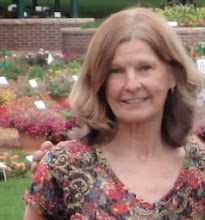If you were to be invited into the
parlor of Henrietta Baker's house, you might not be able to stand
upright--that is if you were older than ten or eleven. When
Henrietta's parents, Henry and Clara, built the playhouse for
Henrietta in 1905, she was 11 years old and an only child. A
Victorian-style home in miniature, Henrietta's house was situated
beside the Baker family home at 428 Crescent Street. The playhouse
was fashioned with horizontal siding below and scallops under the
sharp peaks of the roof. Inside all was gracious and elegant. It was
furnished with child-sized furniture, the walls were papered with
colorful spidery flowers, filmy curtains were hung at the windows,
and small-scale oriental rugs were laid on the floors. And there
were dolls. Lots and lots of dolls. The black and white photo
featured here (used with permission from Fort Walla Walla Museum)
shows Henrietta and many of her doll friends standing on her house's
front porch, probably soon after the house was completed.
The Baker name is a familiar one in
Walla Walla. Henrietta's grandfather, Dorsey Syng Baker, was a
pioneer doctor and railroad builder. He organized the company that
built a line from Walla Walla to Wallula and he was a prominent local
business man.
Now her lovely little playhouse stands
at Fort Walla Walla Museum and is one of many fascinating buildings
in their Pioneer Village. I visited the museum when I first moved to
town a few years ago and was intrigued by its small-scale design and
charming furnishings. Buildings are of course more than structures;
they are manifestations of the people who built them or inhabited
them. I wondered what the story was with this very cherished and
privileged little girl.
I tracked Henrietta through the years
using old issues of the Union Bulletin. She grew up as girls
generally do: she went to Sharpstein Elementary, she performed as a
snowdrop in a children's opera, she attended St.Paul's School, and
she graduated from Whitman College in 1914. But no one would call
Henrietta a typical young woman of the times. Her degree was in
mathematics, unusual for the that era, and she even taught math for a
while at Whitman College during World War ll. She married Lincoln
Earl Kennedy and she had a son and a daughter. Outside of work and
home she was an energetic participant in community activities and
organizations. She was a member of PEO, Phi Beta Kappa, and the
Arts Club, and she was an actress in the Little Theater production of
Harvey, a charming play featuring sweet, gentle Elwood Dowd,
who insists he sees a giant rabbit (invisible to everyone but him.)
Henrietta was cast as Elmer's staid, conventional, disbelieving
sister and got good reviews for her performance. The Union-Bulletin
said Henrietta "carried the brunt of the acting burden with
eloquence and feeling." The role must have been a challenge for
Henrietta since in real life she was anything but conventional.
In fact, she was somewhat of a
character. She gave numerous lectures. She spoke to the Phi Beta
Kappa chapter; her talk was "A Mathematician Looks at the Idea
of God." And her speech for the Seattle Northgate Brunch Club
gives us even more insight into Henrietta's personality. The title of
her talk was "You Never Know What She Will Say," and in the
advanced publicity for the speech Henrietta is quoted as saying that
"being alive is wonderful. She says it all in one breath. She is
a mother. She runs a home and cooks and writes stories and poems. She
went to several colleges and won all the honors in
mathematics---unimportant, she thinks compared to making good pie
dough and stitching a neat seam."
Yes, she even wrote books--two of them.
In later life she traveled extensively and then organized grand group
tours of Europe.
But while Henrietta was flourishing,
her little playhouse was languishing. The house remained at Crescent
Street until Henrietta's parents moved to Park Street and relocated
it there. It was moved again in 1970 to serve as a storage shed at
the Kennedy's cabin on Mill Creek. Over the years the house fell into
serious disrepair, and her grandson encouraged Henrietta to donate it
to Fort Walla Walla Museum to make sure the little treasure of a
house be saved. A trust for its maintenance accompanied its donation
and local PEO chapters provided for its restoration. Happily,
Henrietta was able to guide its repair and furnishing based on her
memories. In 1986 the little house came to rest in the grounds of
Fort Walla Walla Museum's Pioneer Village, where it can be seen
today.
Go to Fort Walla Walla and visit the
little house. You can peer into each of the rooms through one of the
many windows and pretend you have been invited to spend the day there
by that very interesting little girl, Henrietta Baker.



No comments:
Post a Comment